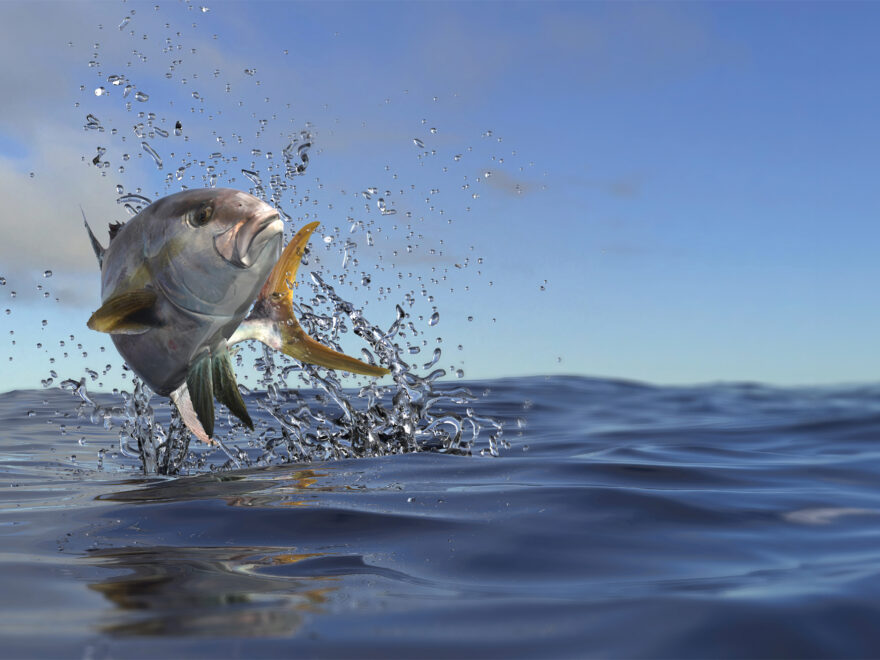When I look back on the last 10 years and see the most significant changes in fishing methodology, techniques and budget ever experienced in New Zealand fishing history. It was in 2007 that I really took to soft plastic fishing on an autumn trip to Great Barrier Island. We were using Bait runner 6500’s and still managed some of the best fishing of our life. And things got better from there.
In 2009 I took a prototype acid wrap mechanical jigging rod up to the Three Kings on Pursuit. My early attempts elicited responses from skipper Rick Pollock that I looked like a special person who’d forgotten my morning dose – but I did get technique sorted and landed some awesome fish jiggling my noodle while the old school boys sat around twiddling their thumbs with live baits down below. More recently micro-jigs and sliders have hit the scene and once again offered a new (actually lower cost this time) craze for anglers to invest in, learn master and grow out of. So what could really be next? Well, it’s not new, but topwater fishing is making a real comeback. Only this time, it’s not poppers but stick baits that are making the, errrrr, splash.
I had the opportunity to fish with Mark Armistead onboard Extreme at Mayor Island a few Octobers ago and experienced what was the best kingfish fishing day of my still growing career. The fish were not massive, averaging about 12kg, and they weren’t extremely hungry. We had four fisho’s on board, two of whom were ardent jiggers plus myself and Ian keen to try this new ‘stick baiting’ thing that Mark was on about. It took two casts, but on that second go I had a 10kg king beat out three others to the bait in a furious display of white water and spray. I was hooked. The adrenaline hit you get from seeing a king smashing your bait (or nearly missing it time and time again!) has yet to be beaten by his fisho.
Since that trip last I’ve spent a bit of time researching stick bait fishing and it’s history in kingfish fisheries. I started off assuming that there would be a wealth of information out here, but strangely there’s not. Kingfish as a target species on stick baits is a fairly recent phenomenon that appears to have been introduced by Japanese fishers, in particular Mr’s Kenji Kinoshi San and Yoichi Mogi San. These guys are real pioneers in recreational fisheries, Mogi San travelling the world to try new techniques on the world’s fisheries and Kinoshi san developing the Carpenter rod and lure range specific to top water fishing. Mogi san has fished more countries that I’ve heard of and landed more trophy fish that any other individual I’ve come across. His webpage has had over 1.9 million hits and is worth the visit, especially if you’re a sucker for huge and unusual fish – I suggest a quick google to see what I mean.
We talk about pioneers like they did what they did way back in the day, but the new world of top water fishing is a new history. It appears that the Japanese Yellowtail Kingfish appear to be a fair bit harder to catch that our friendly hoodlums and this led Konishi san and Mogi san to go some lengths to convince kings up there to take their hooks. Like us here in the 90’s the Japanese threw a lot of poppers at Kingfish, but unlike us they persevered, modifying the designs and techniques of poppering to such an extent that we hardly recognise the finest Japanese poppers as fishing lures at all. All this modification also led to some new innovations that are the stick baits we use today. Stick baits like the Carpenters that Konishi san and Mogi san have developed are such a deviation for old school poppers that they have really created their own genus within the scientific descriptions of lures as we know them. Poppers were originally designed for targeting GT’s (Giant Trevally) in the tropics. GT’s are more likely to attack a splashing, blooping lure than our kingfish which have a more acute sense for lures and will chase poppers a lot, but hit them less. Stick baits, or the better ones at least, can impart a very similar action to an injured, fleeing baitfish that kingfish and other predators cannot resist in the heat of the chase. It’s not just the action of stick baits that sets one apart from the other. Colour, paint quality, ease of use, action and tensile strength are all factors behind what a great stick bait is. To some anglers it’s the action above all else–if it cannot hook fish, why bother? To others it’s longevity and strength–you don’t want to spend your dollars and see it get destroyed after one fish. In about 2003 the Japanese pioneers started producing sturdier, better looking lures that imparted an action that kingfish could not resist. They haven’t stopped researching, which is not a bad thing if you’re a fisho and they certainly haven’t found it a bore. Kinoshi san has often visited New Zealand with his team of field testers to trial some new rods, poppers and stickbaits and always goes home with positive results, even if it’s to find out what doesn’t work.
Stick baiting is still a methodology in the making. There are new techniques, tactics, product sand theories being proposed every week and a lot of the hottest action in New Zealand is coming from the Fishing Website ‘Popping Forum’ where keen kiwi and international fisho’s are sharing their experiences to help refine the sport and increase both fish sizes and catch rates. There is even a forum there for the keenest of all who are designing and making their own stick baits. It’s a great place to go and understand some of the intricate steps required in making resilient and effect stick baits that will attract Kingfish. It also adds a lot of value to the ones you see in the shops. Stick baits, and the tackle designed to fish them are extraordinarily expansive. The lures themselves range from $40 up to $250 for the likes of the Carpenters and Killer series featured in last months video. We’re familiar enough with the reels used by top stick bait fishers, but the rods are something to behold. Incredibly strong, long and whippy for casting but forgiving on anglers during the fight–when you’ve got a 9ft lever working against you a 10kg fish can give you hell.
Once again, Japan is a hot-bed of rod design with new, New Zealand (or really kingfish) specific rods now emerging. These rods can set you back anywhere between $400 and $1200, so this flash new sport is not one to be taken too lightly. So, while you sit there and do you sums and figure out how to convince the better half that the Christmas vacation isn’t as important as the fishing you need to do this weekend check out some of the amazing top water fishing in NZ on Youtube!
Derrick Paull
Fishing Writer


Hi Derrick, I remember those 3 kings adventures on Pursuit well, learnt a few jigging skill there, caught a lot of large king fish ( released most of them ), some large sea bass & a couple of marlin, cheers John
nice writeup Derrick, entirely accurate as I fished with Mogi and Konishi San several times at the 3 Kings and Ranfurly Banks. Mark Armistead accompanied me on some of these trips too. There is no buzz better than a rampaging Kingfish wanting to reef you. The tackle has had to quickly develop to meet these magnificent sportfish and Konishi San is a recognised leader in top water tackle manufacturer.